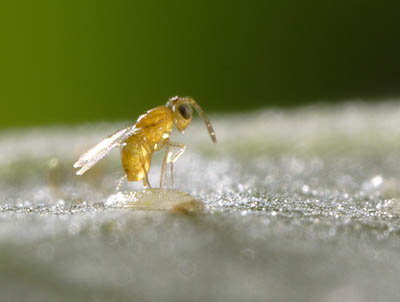
The smallest insect I've ever photographed made the cover of the scientific journal Genetics this week. Encarsia pergandiella, an aphelinid wasp not even a millimeter long, was the subject of a study by Perlmann, Kelly, and Hunter documenting the reproductive consequences of infection by bacterial parasite.
The wasp lab is downstairs from ours, so it wasn't much trouble to schlep my equipment over for an afternoon session. The goal was to create a set of images to submit to the journal as potential covers, and I was more than happy to have the opportunity to shoot these charismatic little wasps. My collection is shamefully deficient in parasitoids, especially considering the importance of these insects. Encarsia wasps, for instance, are the major biocontrol agents for Whitefly.
The shoot took about 2 hours and resulted in 210 RAW exposures. The small size of the wasps- which appear a bit like dust specks to the naked eye- posed an unusual problem. My standard macro lens, the Canon MP-E 65mm, wasn't really enough even at 5x, so I added the only extension tube in my bag to bring magnification up to about 6x. Still not as much as I'd like. One nice thing about Encarsia is that they sit still for a few minutes to lay eggs. This provides me the leisure of trying a variety of lighting and composition arrangements. The shot that was eventually used by the journal employed the backlighting technique I described previously.

From those 210 RAW files, 14 were good enough to process further. I worked up the final selection in photoshop- mostly to remove artifacts of sensor dust- and submitted them to the Genetics editors to review. They tried several comps before settling on the final cover. A few of the unused images are pasted below. And yes, Encarsia really are so small that individual plant cells are visible in the photos.




What are the actual sizes of these wasps?
.8 millimeters, I'm told. They are really, really minuscule.
Congratulations on the cover, Alex. That must have been a fun shoot. I share your enthusiasm for using backlighting!
Those are some very good photos.
To make Encarsia even cooler, because only one larva can survive to maturity in one of the eggs it parasitises, after ovipositing the female will actuall mark the surface of the egg with her ovipositor as a signal to herself and other Encarsia that that egg has been used already.
Beautiful pictures! Do you have pictures of Trichogramma and others? Will you allow others like myself to use your pictures for our lectures to farmers?
Those pictures are awesome. I know nothing of insects but I can appreciate the skill behind these photos.
Nice work !
Congrats! These are lovely!